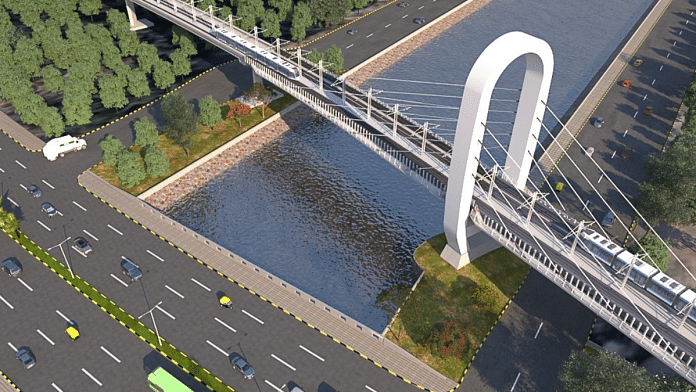Mumbai: There is a big zero being added to Mumbai’s skyline. Defying traditional mathematics where the addition of a zero does not bring about a change in value, this particular one is likely to increase the city’s visual appeal.
The big zero is a new ‘Shunya (zero) bridge’ that the Mumbai Metropolitan Region Development Authority (MMRDA) is constructing as part of an under-construction elevated metro railway line — a 23.5-km corridor from D.N. Nagar to Mandale connecting eastern and western suburbs such as Andheri, Bandra, Kurla and Chembur.
The Shunya bridge is to honour the Indian invention of the number zero, ‘shunya’ in Sanskrit, by Aryabhata, and blend the country’s modern engineering prowess and cultural heritage, according to the MMRDA.
Speaking to ThePrint, MMRDA commissioner Sanjay Mukherjee said that, being the country’s economic capital, Mumbai faces limitations in terms of space for constructing iconic structures.
“Therefore, we are leveraging what we already have, such as metro flyovers, to give the city a fresh and distinctive appearance,” he said.
Also Read: Smart parking, better designed junctions — MMRDA’s plan to decongest Mumbai’s business hub BKC
The design
The ‘Shunya structure’ is part of a cable-stayed bridge on the metro line to cross the Mithi river and mangroves.
Mukherjee said, structurally, the bridge was a necessity as erecting piers was not easy in the water or on land covered with mangroves. One requires a bridge with a longer span — the distance between two piers — that will minimise disruption to the river’s natural flow, he added.
So, it was decided to build a cable-stayed bridge with a span of 80 metres over the Mithi river, and another 50 metres over the adjacent road.
The bridge will have a concrete deck and a steel pylon in the shape of a zero. The idea was that “an aesthetically pleasing bridge can serve as an iconic landmark, attracting tourism, enhancing the city’s image and fostering a sense of local pride and identity,” he added.
The entire structure with the grand oval zero would be visible very well from a distance, said the MMRDA commissioner.
The MMRDA conceptualised the bridge and had a private company, DesignFakt India Private Limited, work out a detailed concept.
Aesthetics in bridges
Cable-stayed bridges typically involve additional costs compared to conventional bridges because of their complex designs, specialised construction materials, engineering requirements and expertise.
However, the MMRDA says that, despite the higher cost, aesthetically appealing structures bring many advantages, such as turning into landmarks and the city’s identifiers and boosting tourism.
Fourteen years ago, the Bandra-Worli sea link gave Mumbai its first cable-stayed bridge — a structure that has become a modern landmark synonymous with the city.
Since then, quite a few other iconic bridges have been planned for the city, including a small cable-stayed bridge constructed above a flyover as part of Mumbai’s first metro line from Versova to Ghatkopar, and a double-decker bridge as part of the Santacruz Chembur Link Road, which was opened for traffic in 2014.
Other such projects include orthotropic steel decks, which are being used as part of the under-construction Sewri-Nhava Sheva Mumbai Trans Harbour Link and multi-layer bridges at the Haji Ali junction as part of the under-construction Mumbai coastal freeway.
“Certainly, aesthetically designed cable-stayed bridges are reshaping the way people perceive and appreciate bridges. Their visually striking and innovative designs are altering the traditional notion of bridges as purely functional structures,” Mukherjee said.
(Edited by Richa Mishra)
Also Read: ‘Unfairly charged twice’ — why Shiv Sena (UBT) wants toll at Mumbai’s 5 entry points scrapped



